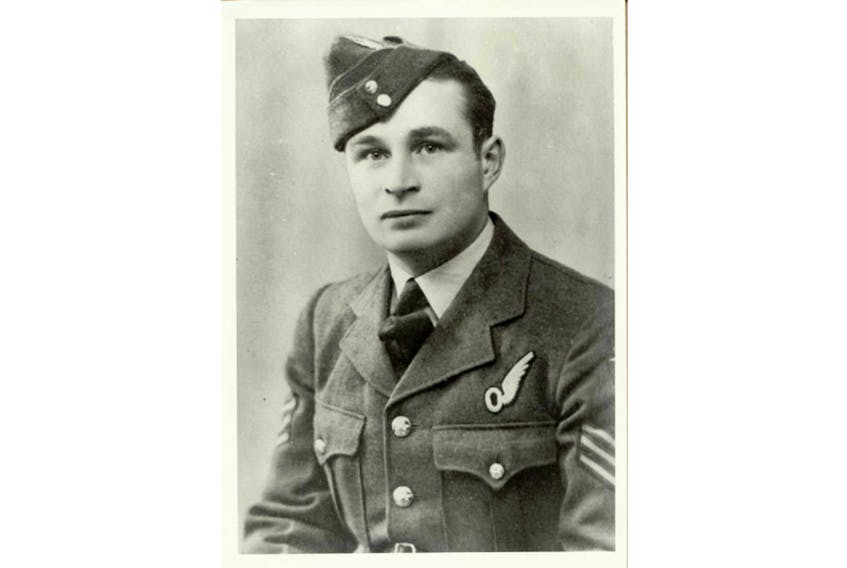TYNE VALLEY, P.E.I. - It was a shot-in-the-dark mission.
“There is really no need to feel over anxious to know that I am back again for my second tour…” wrote Vincent MacCausland, 75 years ago.
The airman penned the sentence shortly before what would be the last flight of his life.
The then 29-year-old bomb aimer from Tyne Valley, P.E.I., a member of the 617 Squadron, was preparing for a dangerous mission – codenamed Operation Chastise – during the Second World War.
It was a mission that he hoped, along with other members of his crew, would deliver a hard blow to the industrial region in the Ruhr Valley in Germany.
“I had the privilege of joining a well-experienced crew and on an aircraft that one dreams about,” the letter to his mother read. “We are on revision and conversion for the next month before going over with a few bundles… I know that you will be feeling most anxious… but the time will soon pass, and I know that God will be especially with us, as we were blessed in that first tour.”
MacCausland, along with the other members of the crew in his modified Lancaster bomber, would nearly make it out, but were given flak at the border of Holland and crashed.
“The mentality among the men, like Vincent, was that they weren’t going to come home. It’s why a lot of soldiers, seamen and airmen had a knack for telling their families what they were doing during the war, without really telling them anything,” said Ted Barris.
Barris is a freelance journalist and author. His most recent publication is about the Canadian presence in Operation Chastise: “Dam Busters: Canadian Airmen and the Secret Raid Against Nazi Germany.”
Barris’ book outlines the weeks prior and post raid as well the events of the moonlit night that saw 19 Lancasters and 133 airmen fly from the squadron base in Scampton, England, to the Ruhr Valley on May 16, 1943.
“Eight aircraft were lost, 53 men were killed and three were taken prisoner,” Barris writes.
This year marks the 75th anniversary of that bombing raid.

Operation Chastise
The Ruhr River Valley region housed Germany’s industrial cities and massive hydroelectric generating dams and reservoirs. Known as “Happy Valley,” airmen on the mission wouldn’t know their target until just before the raid.
“As early as the spring of 1942, the concentrations of industrial plants along the Ruhr had become obvious targets for Allied bombings; as much as 10 per cent of the year’s strategic bombing was directed against those Ruhr Valley targets,” Barris explained in his book.
But this mission was different from the past, as previous attempts to destroy the dams were not successful; at least not until British scientist Barnes Wallace invented the bouncing bomb that would be used in Operation Chastise.

Training for the mission was intense.
“They were going through seven weeks of low-level flying, day and night. They did somewhere between 35 and 50 hours of low-level flying – which was flying a Lancaster as low as a 60-foot tree or a five-story apartment building. They were doing this constantly. The strain and stress of that was traumatic,” Barris said in an interview with the Journal Pioneer.
It was common for members to come back with tree branches in landing gear and some crews had instances where they’d meet a flock of birds.
Each plane had a seven-member crew including a pilot, who flew them there; a navigator who guided them to the right location; a flight engineer, who maintained the engines and made sure they were travelling the 265 miles per hour needed to drop the bomb; the wireless radio operator who ensured the bomb was spinning backwards 500 revolutions per minute; and bomb aimer, who released the explosive.
The mission came a critical moment in the war, said Barris, who has written about other key junctures in Canada’s military history.
“This had been a very dark period of the war. The Americans had just come in after the bombing of Pearl Harbour, the British had managed to get the men out of Dunkirk, but that was a retreat, and for Canada, there was the devastation in Dieppe – often referred to as the nine bloodiest hours in Canadian Military History.”
But along comes this this mission. And while it wasn’t a devastating blow to the Nazis, it delivers a huge moral boost to the Brits, explained Barris.
But the mission was also partly successful with the destruction of two dams and damage to the third, halting the Germans' industrial hub.
“It was a big breath of fresh air.”

"They were thoughtful, and they are revealing of his commitment, fear and illustrate that these guys were trying to make their loved ones feel safe and not worry their families.”
-Ted Barris
Vincent MacCausland
Vincent S. MacCausland was born and raised in Tyne Valley.
Prior to joining the war, MacCausland was a principal at Alberton school.
“He was 29 years old when he joined Operation Chastise and had already completed enough service to be released from active duty. He chose to volunteer,” said Reg MacAusland, a distant cousin of Vincent's.
A tour is a series of operations. One tour usually included about 30 missions. But a term may be multiple tours long before you leave the service. In some cases, the life expectancy for pilots was about three weeks.
“The loss of life was sometimes as high as 10 per cent among pilots,” said Barris.
In a way, said Barris, MacCausland represents the mindset of the time: writing things down to keep as reminders of one’s journey.
“He was typical in that he sugar-coated things. Essentially, they were disguising the true peril they faced and the difficulties in the operations they were flying by saying ‘everything’s fine, we’re OK, nothing new to report here,’” said Barris.
Barris noted MacCausland’s letters indicate his dedication to the war effort as well as other emotions.
“It showed he was angry. That what they would do was deliver a death blow to the enemy. He talks about, using the phrase ‘square-heads’, bordering on a slur referring to the Germans.
“His letters reveal an interesting honesty, as well as some of the trappings of trying to sugar-coat the kind of life they were living and the fear they were feeling.”
Barris was able to access the letters through Vancouver Island University in Nanaimo, B.C.
MacCausland's letters are some of many.
“One thing it points out to me is the propensity to write it down. They were thoughtful, and they are revealing of his commitment, fear and illustrate that these guys were trying to make their loved ones feel safe and not worry their families.”
As a bomb aimer, MacCausland had a critical role to play.
“On the final run into the dam, the bomb-aimer is lying on his stomach in the nose of the aircraft with a very primitive bomb site made of wood, which helps him determine if they are 1,000 yards from the dam, which means they can drop the bomb. He is the final step in the process. If all of the other things are in place, he then lines up the bomb in his Dann Bomb Site and pulls the plunger releasing the bomb,” explained Barris.

Stories that were never told
Barris says the experience of research the book was rewarding.
“These were stories that were never told before. We’ve had Dam Busters books published since the 1960s, but they are very much British and technologically focused. Some of them read like manuals. But when you’ve got family members, and occasionally the people that participated telling their eye witness accounts, you’re there with them. And I wanted to translate that to the readers. This is 30 men, whose stories have been lost to history. And it’s satisfying to know that the stories will last longer now.”









